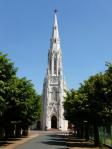
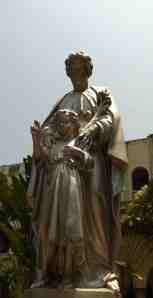 I studied at Loyola College, Madras from 1969 to1972 when I graduated with a B. Sc. in Chemistry. Until last week, when two events took me back there, I had not returned, though I have kept in occasional touch with several of my classmates and many other batch-mates. My years at Loyola were formative, although I should admit that in the callowness of youth, I did not always appreciate just how crucial the discipline of the institution- as well as the freedom it gave me- were. As was the early exposure to a research environment that had nurtured (and been nurtured by) great scholars like Fr. L M Yedannapalli, the physical chemist, and the mathematician, Fr. C Racine – apart from the presence of superb teachers like Klaus Bechtloff, Emmanuel Raja, A V Ramaswamy and N S Gnanapragasam, among others. We keep discussing now whether we should have teachers from outside India in our Universities, but at such institutions then this was not considered much of an issue- Racine was French, Bechtloff was German, and I can also remember an excellent course of lectures on quantum mechanics given by a visiting Belgian, M Mareschal (on the invitation of Dr Gnanapragasam) that was open to all chemistry majors. As I realize more now, those were the good times.
I studied at Loyola College, Madras from 1969 to1972 when I graduated with a B. Sc. in Chemistry. Until last week, when two events took me back there, I had not returned, though I have kept in occasional touch with several of my classmates and many other batch-mates. My years at Loyola were formative, although I should admit that in the callowness of youth, I did not always appreciate just how crucial the discipline of the institution- as well as the freedom it gave me- were. As was the early exposure to a research environment that had nurtured (and been nurtured by) great scholars like Fr. L M Yedannapalli, the physical chemist, and the mathematician, Fr. C Racine – apart from the presence of superb teachers like Klaus Bechtloff, Emmanuel Raja, A V Ramaswamy and N S Gnanapragasam, among others. We keep discussing now whether we should have teachers from outside India in our Universities, but at such institutions then this was not considered much of an issue- Racine was French, Bechtloff was German, and I can also remember an excellent course of lectures on quantum mechanics given by a visiting Belgian, M Mareschal (on the invitation of Dr Gnanapragasam) that was open to all chemistry majors. As I realize more now, those were the good times.
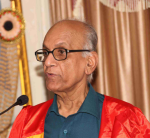 What took me back after all these years was the special ceremony that we organized in order to deliver the Doctor of Science (honoris causa) degree that we had awarded the eminent mathematician C. S. Seshadri in 2012. A collateral advantage was that the same ceremony, we were able to give David Mumford the D. Sc. (h. c.) that we had awarded in 2011. Neither of them is able to travel to Hyderabad to receive the doctorate, so we did the next best thing and went to Loyola College, Chennai. As it happens, Seshadri is an alumnus (as is M S Narasimhan, the other eminent mathematician whom we honoured in 2012 and who spent a few days at UoH in October last year) so it made a lot of sense for us to have the function in the recently built LS Hall at Loyola. A number of eminent mathematicians and other colleagues from a number of institutions- Madras University, Institute of Mathematical Sciences, IIT Madras, Chennai Mathematical Institute, Central University of Tamil Nadu- were there. The ceremony was just about two hours long, and included, in addition to the citation and the degree award, a short seminar on Seshadri’s work and an appreciation of the mentorship of the Rev. Fr. C Racine.
What took me back after all these years was the special ceremony that we organized in order to deliver the Doctor of Science (honoris causa) degree that we had awarded the eminent mathematician C. S. Seshadri in 2012. A collateral advantage was that the same ceremony, we were able to give David Mumford the D. Sc. (h. c.) that we had awarded in 2011. Neither of them is able to travel to Hyderabad to receive the doctorate, so we did the next best thing and went to Loyola College, Chennai. As it happens, Seshadri is an alumnus (as is M S Narasimhan, the other eminent mathematician whom we honoured in 2012 and who spent a few days at UoH in October last year) so it made a lot of sense for us to have the function in the recently built LS Hall at Loyola. A number of eminent mathematicians and other colleagues from a number of institutions- Madras University, Institute of Mathematical Sciences, IIT Madras, Chennai Mathematical Institute, Central University of Tamil Nadu- were there. The ceremony was just about two hours long, and included, in addition to the citation and the degree award, a short seminar on Seshadri’s work and an appreciation of the mentorship of the Rev. Fr. C Racine.
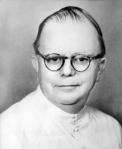 Racine was the moving force that inspired generations of bright students to go into mathematics research. Ordained as a Jesuit priest in1929, he obtained a Ph D in mathematics in Paris in 1934, studying with the finest: his mentors were Élie Cartan and Hadamard and his friends included André Weil and Henri Cartan. From 1939 till his death in 1976, Racine was in Loyola, and I recall seeing him walking in the grounds when I was a student (though he had stopped teaching after his retirement in 1967). Prof. Narasimhan gave a memoir and appreciation of Racine at the function, and here is what I gathered from that talk.
Racine was the moving force that inspired generations of bright students to go into mathematics research. Ordained as a Jesuit priest in1929, he obtained a Ph D in mathematics in Paris in 1934, studying with the finest: his mentors were Élie Cartan and Hadamard and his friends included André Weil and Henri Cartan. From 1939 till his death in 1976, Racine was in Loyola, and I recall seeing him walking in the grounds when I was a student (though he had stopped teaching after his retirement in 1967). Prof. Narasimhan gave a memoir and appreciation of Racine at the function, and here is what I gathered from that talk.
Father Racine had worked with the French mathematicians Hadamard and Élie Cartan and counted among his friends Andre Weil and Henri Cartan among others. More importantly, Racine was well acquainted with the then current trends in mathematics and brought three things to Loyola College, and to Madras University. The first was a new mode of teaching- no rote, no static lectures, a new style of presentation and discussion that engaged the student. The second was the introduction of new courses at the higher levels- something that Madras University had not heard of, a flexible curriculum! And finally, the most important- Racine encouraged his students to go beyond, to find the best places that they could do mathematics in. And so a number of them went to TIFR: K. G. Ramanathan, C. S. Seshadri, M. S. Narasimhan, Raghavan Narasimhan, C. P. Ramanujam…. As well as those who went elsewhere, and that list is even longer…
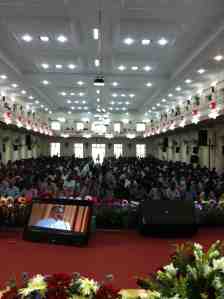 Going back to Loyola was one way of acknowledging debts, and it reminded me of the Princeton alumni song, “Going Back to Nassau Hall”, the notes of which ring loud every June on the Princeton campus when the alumni gather. 6 April was also the 88th College Day, so I was able to return to Bertram Hall (which I had last seen in 1972 when I wrote the B Sc final paper for Inorganic Chemistry, with sweat flowing freely down my forearm…). The tradition of a strong alumni group, that meets and remembers the value that the institution adds to education is very important, and a good way of recalling ones debts to one’s alma mater. And American universities have learned well to capitalize on the goodwill of this group, the Alumni.
Going back to Loyola was one way of acknowledging debts, and it reminded me of the Princeton alumni song, “Going Back to Nassau Hall”, the notes of which ring loud every June on the Princeton campus when the alumni gather. 6 April was also the 88th College Day, so I was able to return to Bertram Hall (which I had last seen in 1972 when I wrote the B Sc final paper for Inorganic Chemistry, with sweat flowing freely down my forearm…). The tradition of a strong alumni group, that meets and remembers the value that the institution adds to education is very important, and a good way of recalling ones debts to one’s alma mater. And American universities have learned well to capitalize on the goodwill of this group, the Alumni.
At the UoH we are only slowly beginning to realise the value of forming Alumni Associations and fostering an external support group for the University- after all, the Alumni are the one group that has the highest interest in the standards of the UoH! We recently had Dr Ch Mohan Rao, Director of the CCMB come and share his experiences with us, and earlier, Sri R V Balaram of the IRS did so too. We need to have more of our old students come back and tell us what makes the UoH such an enabling environment, and how we can make it better. I’m sure we already have enough illustrious alumni who can show us just how much can be achieved… We have an Alumni Cell at the University- do write in with your suggestions, here.

Great to know your Loyola background Sir. I too graduated from a Jesuit educational institution – Andhra Loyola College, Vijayawada, Andhra Pradesh. But, its surprising to know about your Loyola Chennai background, almost after two years of your stay at UoH!! Anyhow, at-least I came to know now. Jesuits pioneered educational sector, especially higher education and persons like us are very fortunate to benefit from them.
I’ve been seeing the attempts to activate Alumni Association at our University since Prof Hasnain’s tenure as Vice Chancellor, and I too wishing to see formation of strong alumni in near future.
We need to run a lot just to stay at the same place… (the predestination paradox?) But then we also want to go to some new places…
I was not aware that CSS and MSN are Loyola products. While in ICTP, I once asked one of my student: I know this old man but I cannot recollect his name. Can you just go and ask him please? She told me tartly: No, I can’t. It is not good manners to ask old Tamil Brahmins their name. You are expected to know. I spoke loudly: Can it be MSN? And he looked up at me. And I was enlightened.
But then there are also rotten apples from Loyola. But that is a different story altogether.
My happiest moment was when one cute young girl walked upto me at the Malpensa airport and wished “Good morning, sir!” It was so nice to meet our own students who have done well and are doing well abroad. I felt like Heine.
Somewhat different memories of Loyola College and personal account of Fr. Racine in my blog
http://gaddeswarup.blogspot.com.au/2008/09/remembering-fr-racine.html
He is also mentioned in a couple of other posts. Regards.
Thanks! I had seen your blog and the post you mention, as well as some others.
First of all we need to be recognised as alumni of UoH, I wish to put my point sir, To facilitate every alumnus to have an ID card, To be attached to UoH family, To not get stopped by security officials entering University :-)))
am replying to your post with some hesitation.
Before I get to the main part of my reply, let me say that I find your posts very inspiring. I would have loved to have had a professor/president like you in the colleges I studied — U of H students are very lucky.
I want to talk about two separate topics — one is very positive and forward looking while the other is not. It is the latter I am hesitant about.
I also studied at Loyola and graduated with a BSc in Chemistry. This was from 1965 to 1968. I know several of the people you mention — Fr. L M Yedannapalli and N S Gnanapragasam. Neither had any impact on me. The former had no dealings with undergraduates. The latter had just come from Georgia Tech and was undergoing his own adjustment problems. Here is what I thought of Loyola, about 10 years ago:
http://creative.sulekha.com/mostly-madras-memories_98767_blog
Now on to the more positive part of my reply.
Our lecture system of teaching had its origins in pre-printing press days. It makes no sense to continue this today. This has been questioned from several different corners, including one from Princeton’s chemistry department. (Maitland Jones.) The alternate techniques produce better learning in students. If this is the sole goal, clearly these should be preferred. (These have been tried in hundreds of courses in dozens of universities. I can provide links.) However, faculty who haven’t bought into this don’t like it. Even faculty who see its value don’t like it because they have to work a lot harder. Top students don’t like it because everybody learns and their advantage is lost. Administrations don’t like it because the neat, clear-cut demarcation into semesters is threatened. The current system works great for teachers — they come and talk [often in the students’ sleep :-)], learning if any takes place _only_ when the students study on their own, some students are marked as “A” students, others as “B” students, etc. and the whole thing is completed in 4 months (say) only to start all over again. The undeniable fact is that some/many students do not learn.
The positive effect on the students by the alternate system is undeniable.
Here is a chance for you to leapfrog not only other Indian universities but also American universities. At the same time, the political costs should not be underestimated. If you like, I can give you some references and contacts.
Some links follow.
https://www.princeton.edu/pr/pwb/02/1118/
http://www.dougshaw.com/uhl/
http://blog.grendel.no/wp-content/uploads/2008/07/the-shame-of-american-education.pdf
http://austlii.edu.au/~alan/j_leged.html
http://en.wikipedia.org/wiki/Keller_Plan
http://www.edtech.vt.edu/edtech/id/models/psi.html
Regards.
Shaker
Hi Shaker (or Shekhar?)
Your experiences at Loyola might differ from what Prof. Ramaswamy has experienced. Students and teachers all differ in their behaviour ( a clue from your name that you posted), it is all a matter of average (not the sum total) of interactions taken together. I read your reply and the first link of Princeton that you gave. Found out the teaching method is the same as mine, only that I have developed this way of teaching on my own. Here is the link to my blog on this: http://seemauoh.wordpress.com/